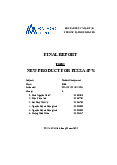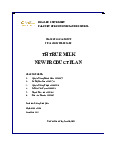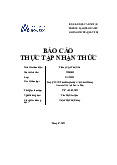




Preview text:
I)
Strategic Launch Decisions:
- Strategic Launch Decisions is the process of deciding and
implementing strategies for releasing new products or upgrading a
company's existing products. Strategic release decisions play an
important role in ensuring the success of a product in the market.
By making a meticulous and considered strategic release decision,
the company can effectively increase its go-to-market and maximize product profits. - It includes: + Strategic platform decisions + Strategic action decisions
II) Some important factors in strategic release decisions include:
- Objective: Determine the specific goal that the company wants to
achieve through product release. Goals can be related to market
share, sales, profits, or other related goals.
- Market: Capture information about the target market and identify
potential customers. This includes market research and analysis,
investigation and understanding of customer needs.
- Competitors: Evaluate competitors in the market and learn about
similar products they have or are offering. This gives the company
a basis to develop distinctive and competitive elements.
- Product set: Determine the product category and the special
features and benefits that the company's products bring. Grasp
competitive advantages and outstanding product features.
- Implementation plan: Develop a detailed plan to implement the
product release decision. This plan may include production,
advertising, communications, distribution and pricing.
III) Packaging should be ▪ Build brand image:
Packaging is vital for creating a brand's image as it's the initial
touchpoint for consumers. By aligning with the brand's identity, values,
and target market through consistent use of colors, logos, and
messaging, distinctive and well-designed packaging can enhance brand
recognition and deliver a memorable customer experience.
Example: The packaging of Apple’s brand often uses a simple and neat
white color scheme, combined with the apple logo that has become the company's symbol. ▪ Difference in category:
In a competitive market, packaging can be a powerful tool to
differentiate a product from its competitors. This can be achieved
through innovative and unique packaging shapes, materials, or finishing
techniques that make the product visually distinctive on the shelf.
Highlighting unique selling points or product benefits prominently on
the packaging can also help create differentiation in the category.
Example: Let's take the example of Method, a company that produces
eco-friendly cleaning products. Method's packaging features vibrant
colors, sleek and modern designs, and unique shapes for their bottles.
▪ Easy to display and inventory, shipping:
Practical considerations such as the ease of displaying products on
shelves, efficient inventory management, and safe shipping are essential.
Packaging should be designed to make products easy to stack, display, and access for consumers.
Example: The Lay's brand has designed their product packaging to be
easily stacked and displayed on shelves, helping to optimize display
space in stores and supermarkets.



